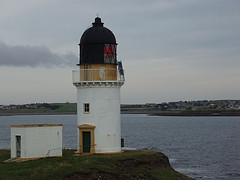Tomorrow, I shall once more make my way northwest to Stornoway. In a direct line, that is a distance of 625 miles or 1,000 km. From door to door, this will take me about 11 to 12 hours - all being well. With a couple of hours waiting time at Gatwick, total flying time is 8 hours. Apart from a scheduled entry, which will appear automatically on Atlantic Lines later tomorrow, my next post should be made on Tuesday. The Shell Gallery will go back under wraps, much like its real life namesake at the Castle was today.
Once more, I'd like to thank you all for reading and hope you'll rejoin me on Atlantic Lines come Tuesday.
Sunday, 1 February 2009
1 February 1953
The above map of southwestern Holland shows the areas in the provinces of Zuid Holland, Noord Brabant and Zeeland under water on the morning of 1 February 1953, in other words 56 years ago today. By time of posting, more than 1,800 people had drowned. A detailed account can be found here - please be aware that this site is originally in Dutch, but is being presented to you in English through Google Translator.
The disaster had started the day before, when a deep depression had moved southeast from Iceland towards northwestern Europe. On its western flank, hurricane force northwesterly winds battered Scotland - forcing the cargo ship Glen Macquarrie ashore near Borve on the Isle of Lewis, and smashing in the bowdoors of a ferry in the Irish Sea, sinking it with all hands - then eastern England. The high winds drove a springtide into the shallows of the southern North Sea, augmenting it as the narrows of the Strait of Dover did not allow sufficient drainage of the tidal surge. As a result, by 6pm on 31 January, the low tide saw the sea already dangerously close to the tops of the dykes in southwestern Holland. By midnight, high tide coincided with the height of the storm, causing the dykes to break.
The poor communications of the day, together with the fact that radio did not transmit at night, meant that the warnings came too late for many. The ringing of church bells was the only warning many got. Some got away in their attics, after the roofs floated away from the walls of the houses. The accounts are still available (in Dutch), but are a chilling reminder of the horror of that day.
The "Watersnoodramp", as the event is called in Holland, marked a turning point in thinking about coastal defences. After being on the backburner for more than 30 years, the dykes in the southwestern provinces suddenly became top priority. All the estuary mouths were closed off in the following 35 years, apart from the Westerschelde, which is the access route to Antwerp.
Fatalities did not just occur in Holland; 300 people died around the Wash and in the Thames Estuary in England.
1 February
February made a white and very cold start in Holland. Awoke this morning to a thin (1 cm / ½ in) cover of snow and a strong easterly wind. This served to make the -1C on the thermometer feel even colder than it ordinarily would.
Went to church to augment the number of tenor singers from 1 to 2. Good service this morning, very topical and to the point. In the past, perhaps of being of a younger age, I'd yawn my way through a sermon, but not these days. Had to be careful on the streets outside; church here is surrounded by cobbled stones and (as anything in this village) stands on a sloping street. You can safely discard the idea that Holland is flat. It ain't.
After lunch, we went to the cemetery to place flowers on my mother's grave. Hopefully, the addition of sugar to the water and the fact that there were quite a few flowers will help to extend their life in these freezing conditions. On return, we found that the Castle Country Park had been opened for visitors (it normally doesn't open until April 15th), so we ventured in. The main features had been wrapped in tarpaulins to protect them against frost. The wind made it very cold, so we did not stay long. A pity, as it is one of my favourite places in the village.

Orangerie

Castle and Countrypark

A white awakening
More pictures here
Went to church to augment the number of tenor singers from 1 to 2. Good service this morning, very topical and to the point. In the past, perhaps of being of a younger age, I'd yawn my way through a sermon, but not these days. Had to be careful on the streets outside; church here is surrounded by cobbled stones and (as anything in this village) stands on a sloping street. You can safely discard the idea that Holland is flat. It ain't.
After lunch, we went to the cemetery to place flowers on my mother's grave. Hopefully, the addition of sugar to the water and the fact that there were quite a few flowers will help to extend their life in these freezing conditions. On return, we found that the Castle Country Park had been opened for visitors (it normally doesn't open until April 15th), so we ventured in. The main features had been wrapped in tarpaulins to protect them against frost. The wind made it very cold, so we did not stay long. A pity, as it is one of my favourite places in the village.
Orangerie
Castle and Countrypark
A white awakening
More pictures here
Subscribe to:
Comments (Atom)
